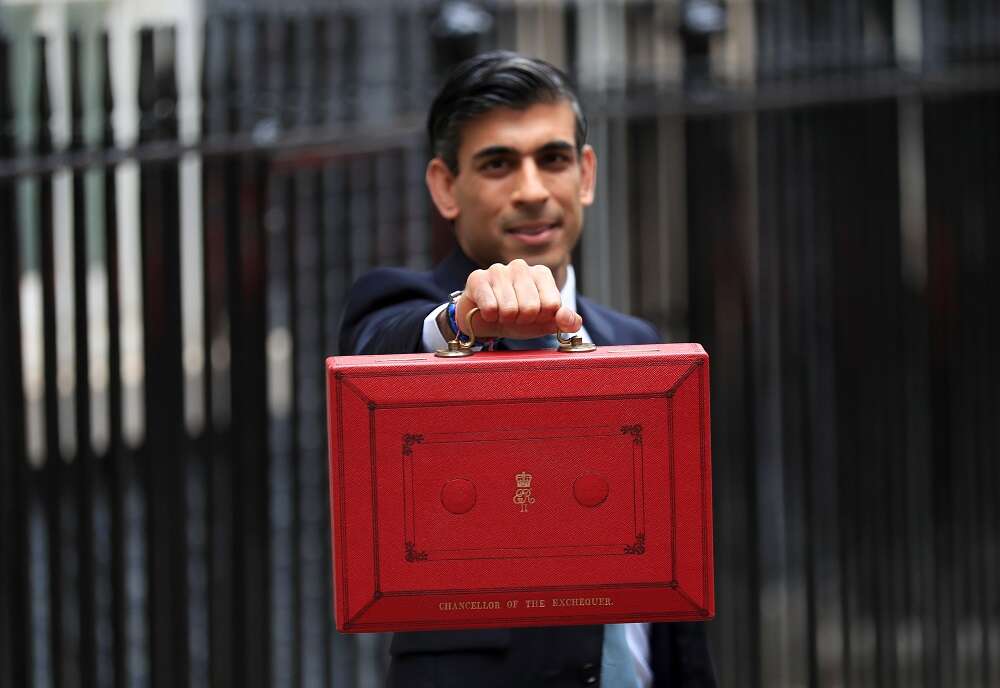
By David Milliken, Andy Bruce and William Schomberg
LONDON (Reuters) -Finance minister Rishi Sunak used an upgrade to Britain’s economic recovery forecasts to promise higher public spending and new tax cuts, and he vowed to protect households from the sharp rise in inflation that could approach 5% next year.
Sunak announced multi-billion-pound investments to help Prime Minister Boris Johnson meet his “levelling up” promises to voters and ease a cost-of-living squeeze for low-earning households in a half-yearly budget statement on Wednesday.
But the plan came with a cost: Britain’s budget forecasters said the state’s tax take was on course to be its biggest since the 1950s, thanks to big tax hikes announced in March and September, while public spending was set for its largest sustained share of economic output since the late 1970s.
In a speech to parliament, Sunak hailed the improved growth forecasts that reflected the economy’s post-lockdown bounce-back and said he wanted to return to his Conservative Party’s traditional policy of cutting taxes before the next election, due by 2024.
The new forecasts from the Office for Budget Responsibility showed the economy was expected to grow by 6.5% in 2021, up from a forecast of 4.0% made in March, when Britain was still in a coronavirus lockdown.
“Today’s budget does not draw a line under COVID. We have challenging months ahead,” Sunak said. “But today’s budget does begin the work of preparing for a new economy post-COVID.”
The higher growth forecast for 2021 meant the economy was expected to regain its pre-pandemic size at the turn of this year, not in the second quarter of 2022 as predicted in March although it was still later than in other countries.
Long-term damage to the economy would also be lower, with 2% of output lost permanently, compared with 3% estimated before.
Sunak – who racked up Britain’s biggest-ever peacetime budget deficit to combat the coronavirus – will now be able to borrow less than previously expected.
The OBR projected the deficit for the financial year to the end of next March would be equivalent to 7.9% of economic output – down from its previous forecast of 10.3% and almost half the size of last year’s historic shortfall.
The OBR cut its forecasts for borrowing in each of the subsequent four financial years.
British government bond prices rose and the yield on 30-year gilts hit a one-month low on the reduced debt sale plans.
Sunak defied expectations that he would squeeze spending in many government departments, saying they would all get a real-term increase in spending, and he promised the biggest increase in a decade in the core funding of local governments.
But Ben Zaranko, an analyst at the Institute for Fiscal Studies think thank, said the highest spending was not enough to reverse the cuts of the 2010s.
“Austerity is over, but not undone,” he said.
Sunak also announced new rules to govern borrowing: underlying public sector net debt must be falling as a share of GDP and day-to-day government spending must be balanced by revenues within three years.
The OBR said Sunak was just about on course to meet those rules.
On taxes, Sunak lessened the hit for low-income families in work from the loss of a pandemic emergency top-up of welfare benefits. He also cut business rates for a year for hard-hit sectors such as retail and hospitality and froze them for others.
The benefit changes cost more than 2 billion pounds a year, while the cuts in business rates cost 2.7 billion pounds next year and more than 900 million pounds a year thereafter.
Drinkers would be spared a planned increase in duty on alcohol worth more than 600 million pounds a year.
“WILLING TO ACT” ON INFLATION
Sunak acknowledged the risks posed by rising inflation, much of which he blamed on problems in the global economy.
The OBR predicted inflation would hit almost 5% next year, and it said post-Brexit migration and trade rules had exacerbated supply bottlenecks in Britain.
“I understand people are concerned about global inflation – but they have a government here at home ready and willing to act,” Sunak said.
He announced further measures to ease a shortage of truck drivers and said the increases in spending would done “keeping in mind the need to control inflation.”
A big risk for Sunak is that the recent jump in inflation lasts longer than expected and pushes up the government’s debt costs sharply. A quarter of British gilts are indexed to inflation, more than most other rich economies.
A 1 percentage-point rise in interest rates and inflation would cost taxpayers an estimated 23 billion pounds a year, double the money Sunak plans to raise via higher social security contributions to fund the health service and social care.
Borrowing costs could start to go up as soon as next week when the Bank of England announces its November policy decision.
(Additional reporting by Paul Sandle, Kate Holton, William James, Kylie MacLellan, Andrew MacAskill and Costas Pitas; writing by William Schomberg and David Milliken; Editing by Hugh Lawson)


